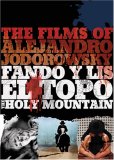| Reviews & Columns |
|
Reviews DVD TV on DVD Blu-ray 4K UHD International DVDs In Theaters Reviews by Studio Video Games Features Collector Series DVDs Easter Egg Database Interviews DVD Talk Radio Feature Articles Columns Anime Talk DVD Savant Horror DVDs The M.O.D. Squad Art House HD Talk Silent DVD
|
DVD Talk Forum |
|
|
| Resources |
|
DVD Price Search Customer Service #'s RCE Info Links |
|
Columns
|
|
|
Films of Alejandro Jodorowsky, The
One of cult cinemas holy grails is finally unleashed with this boxed set, The Films of Alejandro Jodorowsky. Long held up in a dispute between Jodorowsky and producer Allen Klein of ABKCO Films, fans have had to make do with inferior bootleg copies for decades. With the two men having finally made peace with one another, ABCKO Films (with distribution through) Anchor Bay has given us a fantastic boxed set compilation which includes El Topo and The Holy Mountain on authorized DVD for the first time alongside the previously issued Fando Y Lis and accompanied by Jodorowsky first movie, La Cravate, long thought to be lost for good and only recently found in Germany. Completed with the full participation of the director and featuring all new high definition sourced transfers which he personally approved, this boxed set is literally a dream come true for fans of surrealist and unusual cinema. While it's a shame that his other films were not included - Tusk, The Rainbow Thief and especially Santa Sangre - this boxed set is a huge step in the right direction towards getting the influential and controversial filmmaker's work properly archived on DVD. Here's a look, in chronological order, at the four films in this set:
La Cravate:
Long considered lost until it was found in Germany in 2006, Jodorowsky's first directorial effort was La Cravate, an odd filmed version of a play performed without any dialogue using mime techniques. The story follows a smaller, artistic looking man (Jodorowsky) who visits a shop where a woman takes your head and puts it on a different body. The thuggish man who accompanies him pushes Jodorowsky's character out of the way and soon he's had his had taken off and put on a shelf, a new noggin now attached to his body.
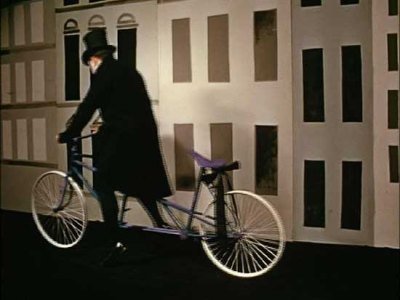
Jodorowsky wanders off and meets a woman in a purple dress wearing heavy white make up on her face and he does his best to woo her but ultimately, she's just not interesting. He decides to pay the 'head shop' another visit and after trying a few different heads on he finally settles on the thuggish man's head. Jodorowsky's original head is put on a shelf where it plays the flute as his body wanders off and gets into trouble. Eventually, his body wanders back and is reunited with his head and they apparently live happily ever after.
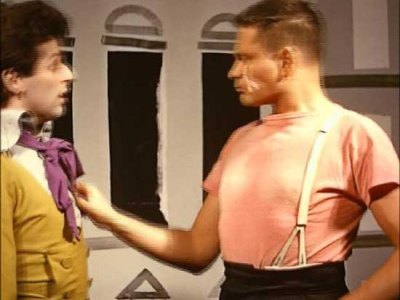
Filmed on a very low budget on a stage using theater props and costumes, La Cravate is a strange little film. Though it isn't without its considerable charm, it plays out much more like an amateur theatrical production than an actual movie, which isn't at all surprising considering that at the time this movie was made Jodorowsky was very much involved in live theater. Although the film lacks the multi-layered symbolism of his later and more renowned films, as an early exercise in filmmaking La Cravate is an interesting experiment. The story is told primarily with body language and it's interesting to see how the characters exaggerate their faces and their torsos to get their points across when they can't express themselves verbally. The cinematography is fairly pedestrian and the visuals aren't overly impressive but for an early experimental short film, La Cravate is a well-made and cute little piece of cinema. Look at this one as more of a curiosity item than a feature attraction – it's a piece of Jodorowsky's history.
Fando Y Lis:
Jodorowsky's feature length directorial debut is loosely based on a play by Fernando Arrabal. An interesting opening credits sequence tells us about the mythical lost city of Tar, a sort of Heaven on Earth and the only place left in the world where people can find true happiness. Enter Fando (Sergio Kleiner) and Lis (Diana Mariscal), a pair of unusual lovers. Fando is a temperamental young man who is very vocal about his undying love for Lis, who has lost the use of her legs. He puts her on a cart with a doll, a gramophone and a drum and together they set out across the desolate landscape in search of their Shangri-La, Fando pushing her all the way.
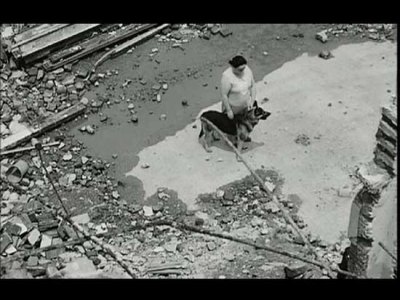
As their journey progresses, the come into contact with an increasingly bizarre cast of characters. After stopping at a cemetery and making fun of the graves and striking some rather sexual poses for the camera, the pair meets a group of elitist bourgeoisie types, a gang of orgying mud people, a strange and sinister pope, a naked pregnant woman, and a man who may or may not be a vampire. At one point the stop to paint each other's bodies (and Lis walks under her own power) in one of the film's highlights. As they get closer to their destination, their relationship begins to strain and Fando's temper begins to show and his treatment of the woman he claims to love becomes more and more abusive.
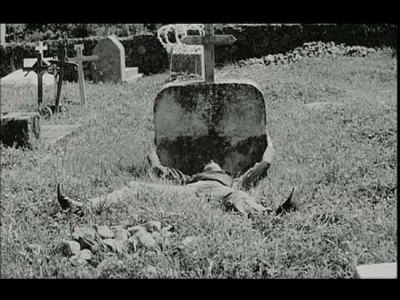
A stirring example of fairly early surrealist cinema, Fando Y Lis has a lot to offer attentive viewers. Rich with symbolism, freakish imagery and beautiful cinematography the film moves along at a good pace taking its central characters and in turn the audience from one bizarre set piece to the next. Controversial enough that it landed its director in some very hot water with the Mexican film community, the movie feels influenced by the likes of Luis Bunuel and Pier Paulo Pasolini but it also stands out on its own as 'uniquely Jodorowsky.' Containing scenes of what the director claims are authentic blood drinking and actual violence; the movie isn't one that will appeal to the faint of heart or those with easily upset sensibilities. It takes more than a few obvious pot shots at the Catholic Church by portraying the pope as an evil and perverse character and it doesn't exactly pull any punches in its portrayal of the wealthy characters in the film, three of whom are responsible for Lis' rape at an early age, a scene which is shown quite graphically in the film. Jodorowsky himself shows up in a bit part as a puppeteer, another role in which he portrays himself as God in a sense, and the director's seeming disdain for women, which is a recurring theme in El Topo is easy to spot here when Fando's treatment of Lis finally takes him over the deep end towards the end of the movie. At the same time, the director wraps things up on an oddly bitter sweet note that suits the film perfectly.
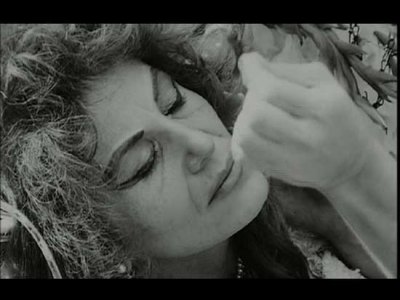
El Topo:
A black-garbed gunfighter, El Topo, accompanied by his young, naked son ride through the desert on their horse. They stop in a seemingly random location where the gunfighter tells his son that it is time he became a man and forces him to bury the picture of his mother and the small toy he is carrying with him. They then ride to a nearby town where the inhabitants lay dead, seeping torrents of blood into the streets. A group of bandits led by 'the Colonel' are responsible according to the one loan man still left alive, so El Topo tracks him down, castrates him and tells him that he is God before the Colonel kills himself in front of his men.
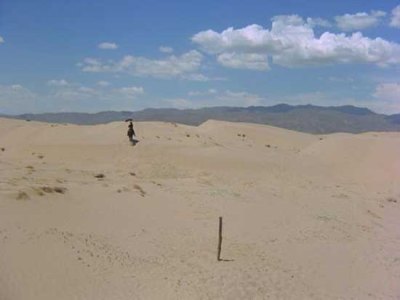
Mara, the Colonel's personal sex toy, rides off with El Topo and convinces him that he should hunt down the four masters of the desert, a group of gunfighters that seem to have reached some heightened state and can no longer be killed by conventional methods. As El Topo takes down his opponents, in turn he becomes what they were and adds to his abilities until he too reaches a heightened state.
Through an odd twist of fate, at the end of this quest El Topo becomes disillusioned with life, and retreats off to the caves to become a monk, where he may or may not have been reborn. The end of the film places El Topo at a crucial paradox where his past confronts him and he must question everything that he believes in.
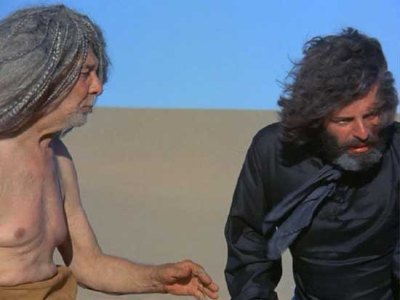
At times both reverent and blasphemous, El Topo, which means 'the mole' in Spanish, transcends traditional 'spaghetti western' boundaries and becomes very much it's own unique beast. Adding to the films unusual ambience is the fact that writer/director Jodorowsky not only plays the title character, but also cast his real life son, Brontis Jodorowsky, as his naked companion at the beginning of the film. Interesting then that the film deals with paternal issues using various characters to represent Jodorowsky's real life father. Although the film is blatantly bizarre, it's really a fictional document of one character's life and subsequent rebirth in his pursuit for truth, meaning and justice. When the character of El Topo shaves his head and changes his occupation he fully intends to change his ways and work for the greater good. It's only when he completes his tunnel and he frees the 'monsters' who are subsequently slaughtered by the townsfolk that he's once again forced into his old and violent ways. Is this a statement on the nature of man? Humanity's inherent penchant for violence? Or is it simply an interesting plot device that provides ample opportunity to exploit bloody violence and shock the audience? The truth is, it's both and Jodorowsky would be the first to admit it. The film manages to combine scenes of shocking bloodshed with violent sexuality and then contrast them with tender and romantic character driven moments and transcendental scenes of mysticism. Shot using very few close ups and with a cast of relatively unknown actors and actresses most of whom Jodorowsky simply 'found' the picture has a very unique look. It recycles sets from old westerns and takes place primarily in the desert of Mexico, but its themes and message are not wholly confined to that one specific location and in fact are quite universal.
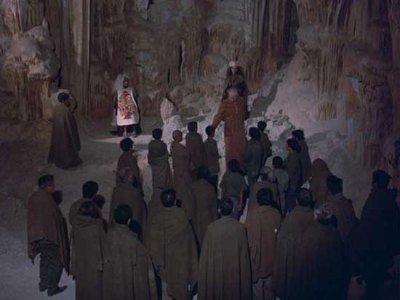
Filled with surreal religious imagery, violent symbolism, and shocking metaphors, the film leaves both everything and nothing to your imagination with stunning cinematography, and stirring locations. Jodorowsky is manic but believable and lends some very personal influence to his film. Very much a spiritual western, with more than a hint of Leone influenced grandeur, El Topo is a true cult classic.
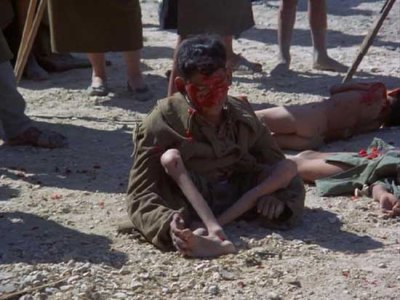
The Holy Mountain:
Alejandro Jodorowsky's follow up to his cult hit El Topo is a strange and surreal journey through the world of mysticism and the occult that forgoes the black leather clad Spaghetti Western styling of it's predecessor and instead focuses on the magical and spiritual aspects of various world theologies.
A thief bearing no small resemblance to Jesus Christ finds himself wandering through a strange world of religious imagery and strange arcane rituals. He eventually climbs a massive red tower (and in turn reaches a different spiritual plane) by using some large balloons and is taken in by 'The Alchemist', a mystical figurehead who, after proving himself by turning the thief's fecal matter into gold, introduces him to six powerful strangers of varied occupations (and based on the Tarot), each seeking enlightenment.
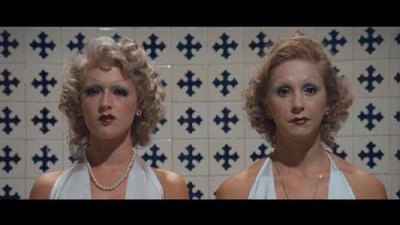
Each one of these individuals, naked and shaved, represents a different planet in the solar system. Teaming up with the thief and the Alchemist along with his assistant, they strip themselves of their possessions, burn all their money, and try to remove any form of self from their souls. Together they form a group who attempt to climb the Holy Mountain where they expect to overthrow the immortals that reside there and find true spiritual enlightenment.
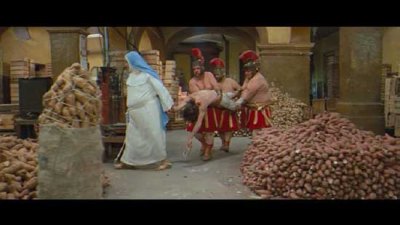
Filled with its fair share of shocking imagery and sadistic violence, The Holy Mountain is a totally unique film filled with gorgeous compositions and amazing set pieces. The infamous reenactment of the Mexican revolution using frogs (as Spanish conquistadors) and lizards (as Aztecs) is humorous and disturbing at the same time, and in a sense it sets the tone for the rest of the movie. The thief, who is obviously a metaphor for Christ (when we meet him he is coming down off of a cross) and who is compared to him on more than one occasion not the least of which is when he drives the money lenders from the temple, represents all of us and mankind's need to find God in whatever form we may deem fit. Jodorowsky has said that with this film he hoped to make a sacred piece of cinema and so he uses symbolism from various different religions to build his own take on theological enlightenment.
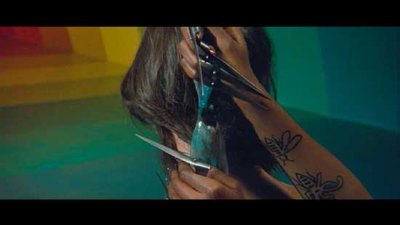
Once again, Jodorowsky has cast himself in the lead and surrounded himself with primarily unknown performers. His theory on this is that having a star in your film is a waste of money that should be spent on production values rather than on arrogant talent and in many ways his theory is quite astute. Here he has made an absolutely beautiful film that is at times very down to Earth and at other times very alien in appearance. There's obviously been a lot of care put into each shot as well as into the set decorations and into the costumes and it pays off as the film is gorgeous to look at even if at times it's a little hard to decipher without an innate knowledge of world religions and the occult.
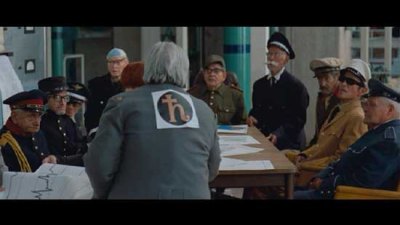
Leaving itself wide open for individual interpretation while at the same time having a fairly straightforward narrative, The Holy Mountain is a film just waiting to be explained, likely in a different manner by each person who sees it.
The DVD Video:
All four of the films in this set were transferred from the original vault materials, and El Topo and The Holy Mountain were done in high definition and then down converted for standard DVD presentation.
La Cravate:
It's understandable that La Cravate doesn't look quite as sharp as the other films in this set and unfortunately it isn't flagged for progressive scan playback and it shows some saw tooth artifacts. It looks like it was shot on 16mm and was obviously made without much of a budget. When you take into account that the only copy of the movie was sitting in an attic in Germany until last year, it's amazing that it looks as good as it does on this DVD. The fullframe transfer shows a fair bit of grain and some mild print damage but aside from that there is little to complain about. Colors hold up well and if the blacks area little washed out, it's not that big a deal. Detail is a bit soft sometimes but this looks to have more to do with the elements and the condition that they were in more so than the transfer itself.
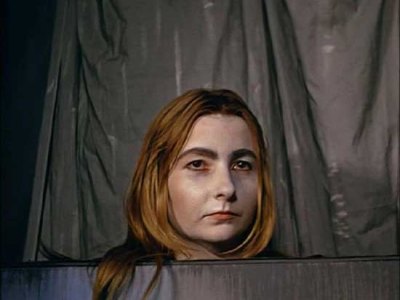
Fando Y Lis: Unfortunately, Fando Y Lis is not enhanced for 16x9 sets although there is some difference between the transfer in this set and the one that appeared on the now out of print Fantoma DVD. Unfortunately, this transfer is also not properly flagged for progressive scan playback either. Although that, that disc looked pretty good in the first place as it was transferred from the original negative, this disc is slightly cleaner looking with less obvious grain and print damage. There are some strobe effects that occur during some of the brighter scenes that are mildly distracting but aside from that, there's not much to complain about. The new transfer still shows a little bit of grain and some mild print damage here and there but for the most part the black and white picture is quite clean and fairly detailed. Edge enhancement isn't overly problematic and there weren't any compression artifacts worth noting. Contrast and sharpness levels look accurate and fine detail in both the foreground and the background of the image is surprisingly revelatory.
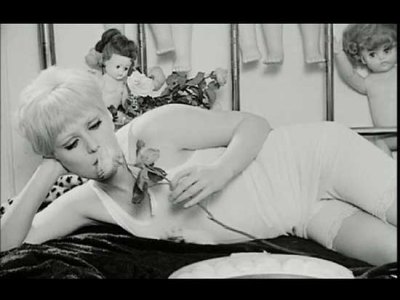
El Topo: Those who have only ever seen this film by way of the various grey market bootlegs in circulation or the PAL release from RARO Films in Italy are in for a revelation. Although there is still a bit of grain in some scenes and the odd speck or two on the image, by and large the restoration done on this film has rendered the picture to near pristine condition. There are no problems with mpeg compression artifacts at all and barely a hint of edge enhancement to be found. Color reproduction is astounding and black levels are strong, deep and consistent throughout playback. Fine detail in both the foreground and the background of the image is top notch and the 1.33.1 fullframe presentation on this director approved transfer presents the compositions in their proper aspect ratio. In short, El Topo looks infinitely better on this disc than any previous home video release thus far in its history. Thankfully, there are no flagging issues here and the progressive scan playback is problem free.
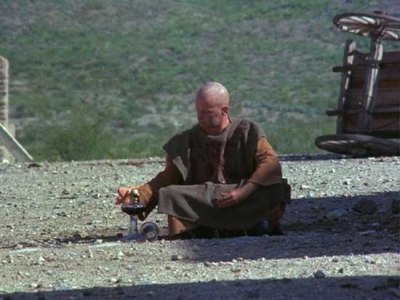
The Holy Mountain: The 2.35.1 anamorphic widescreen restored transfer for The Holy Mountain is just as sharp and colorful as El Topo's sterling presentation. Color reproduction looks dead on and there are no problems with print damage save for a few tiny specks here and there. Mpeg compression is not a problem and while there is some minor shimmering in a couple of spots it's easy to overlook this as it isn't ever overbearing. Flesh tones look lifelike and natural and fine detail is fantastically sharp. Again, this transfer easily trumps both previous grey market releases and the PAL disc that was issued by RARO Films a few years back.
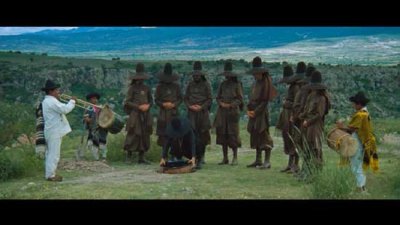
Audio options are provided for the four movies as follows:
La Cravate: Dolby Digital 2.0 Stereo (music only, no dialogue).
Fando Y Lis: Spanish language only in Dolby Digital Mono.
El Topo: Spanish language Dolby Digital 2.0 Stereo and 5.1 Surround Sound, or English language Dolby Digital 2.0 Stereo.
The Holy Mountain: English language Dolby Digital 2.0 Stereo and 5.1 Surround Sound.
Optional subtitles are available for each film in English, French, Spanish and Brazilian Portuguese. As far as the quality of the mixes goes, there's little to complain about. Fando Y Lis still sounds very raw and at times quite distorted, but it's supposed to sound that way. The surround mixes on El Topo and The Holy Mountain are fun in that they spread things out and make the surreal films even more unusual, while the 2.0 tracks do a fine job as well. It's nice to see the English dub included on El Topo. Even if the film doesn't play as well in that language, it's interesting to see it presented that way. Expect a little bit of hiss here and there but aside from that, dialogue is clean and clear and there are no unintentional problems with hiss or distortion.
Extras:Extras are, as you would expect, spread across the discs in the set and not confined to one single disc. Here's a peek:
La Cravate:
Aside from a text screen containing restoration and DVD credits and a main menu screen, there are no other supplements to accompany this rare film.
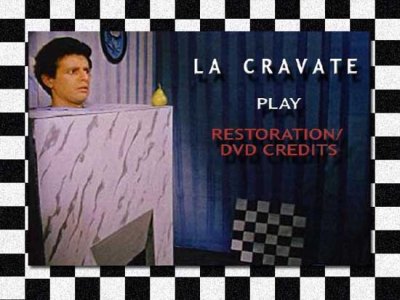
Fando Y Lis:
ABKCO Films has ported over the commentary track from the Fantoma release of Fando Y Lis and included it on this new disc. The track is in English and Jodorowsky speaks with a fairly thick accent but he's reasonably easy to understand even if it's obvious that English isn't his first language. He tells a few interesting stories about the movie and it's rather unusual history, starting by explaining how the movie was based on a play by Fernando Arrabal (fellow Panic Movement member and director of surrealist classics like I Will Walk Like A Crazy Horse) that he and his theater troupe were performing. He shot the movie with only one page of notes and much of what we see was made up on the spot. The director tells us of his penchant for using found talent rather than working with establish actors, and he then goes on a rather bizarre rant against Peter O'Toole (who he worked with on The Rainbow Thief in 1990) and the very idea of celebrity actors. He discusses in a fair bit of detail the controversy surrounding the film and how when it debuted at the Acapulco Film Festival there was a riot during the screening. Threats were made on Jodorowsky's life and he was more or less blacklisted in the Mexican film community for a while, as were some of the performers involved in the picture. He points out interesting details along the way, noting where his wife at the time appears in the picture and telling us how she had a beautiful body that kept getting attacked by mosquitoes during the shoot and how she was a wonderful woman until he married her and then she became evil! He discusses the scene in the cemetery, talking about how he and his crew had to move in and shoot it very quickly so that the locals would not see him, because if he were caught they're probably have killed him for creating blasphemous imagery. He details some history of various bit part players, noting that it's actually a woman playing the pope in the picture and not a man, thus making the kiss scene a lesbian scene and he talks about his unusual relationship with Samuel Rosemberg (son of Moshe Rosemberg who produced El Topo and The Holy Mountain), who has a bit part in the movie, to whom Jodorowsky dedicated the film (he passed away while smoking in his bed shortly after the film was completed). There are a few stretches of silence in the track but for the most part this is an excellent track that does a great job of shedding some light on the director's intent and his methods as they pertain this early part of his movie career.
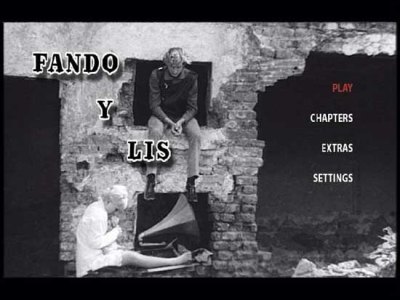
Also included on this disc, and presented in its entirety, is Louis Mouchet's feature length documentary La Constellation Jodorowsky. Familiar to those who own Fantoma's Fando Y Lis DVD or Anchor Bay UK's Santa Sangre two disc set, this feature length film takes a detailed and personal look at the man who made the feature on the first disc, and it gives the viewer a nice opportunity to sort of find out what Jodorowsky is all about. With its opening question, simply 'Who are you?' (to which he answers with a strange story concerning a Chinese emperor!) to its closing moments, the film treats its subject with respect but isn't afraid to probe a little bit when asking questions. Ground covered in the almost ninety-minute running time runs the gamut from art to philosophy to religion to the quest for knowledge and spiritual enlightenment. Considerable time is spent dealing with his shelved adaptation of Frank Herbert's Dune (which ultimately was brought to the big screen by David Lynch, and then later remade again as a Sci-Fi Channel mini-series), as well as the Panic Movement which he, along with Fernando Arrabal (director of I Will Walk Like A Crazy Horse and Viva La Muerte!) and Roland Topor formed in the early sixties. All in all, this is a very worthy companion piece to the films in the boxed set and it was a brilliant decision on the part of ABKCO Films to include this film among the extra features. Sadly, the shot on video origins of the piece preclude it – it doesn't look so hot, but it's watchable enough. Regardless, the content is great and if you've any interest at all in Jodorowsky's work, you owe it to yourself to check it out.
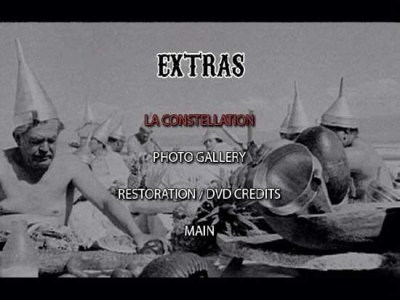
Rounding out the extra features on this disc are a still gallery, a DVD and restoration credits screen, static menus and chapter stops.
El Topo:
The most important extra feature on the El Topo DVD is an audio commentary from Alejandro Jodorowsky, conducted in Spanish with English subtitles. Rather candid at times and refreshingly blunt about where he was at in his personal life while making this picture, Jodorowsky explains some of the symbolism in the film and gives us quite a bit of information about the picture. He explains how the rape scene was not faked and how he found the actress who played the first female lead while she was sort of wandering around permanently stoned after taking five hundred hits of LSD. He's open about the misogyny of the film and admits that he was quite down in his portrayal and his thoughts on women at this point in his life and he details how John Lennon and Yoko Ono opened the doors for this picture. Jodorowsky also explains some of the semi-autobiographical parts of the film, pointing out where his wife at the time appears and how his son Brontis was brought on to play the young naked boy at the beginning of the movie. He elaborates on the female and male side of the character of El Topo and discusses his thoughts on gender psychology and he explains some of the religious symbolism that plays a key role in the picture. He also addresses the film's critics, defending the film's brutal violence and explaining why it's there in the first place, and at the same time he expresses regret over the real life animal violence we see in the movie. He covers the paternal and maternal issues he dealt with as a child that play a part in the themes of the film and he talks about Elvis' influence on El Topo's costume. He also explains the changes that El Topo the character goes through, the meaning of the title and how it relates to the tunnel as well as his use of physically handicapped actors and actresses in the film, explaining that he's drawn to real life monsters and sees them as biologically creative. Make sure to listen to the track all the way through, as over the end credits Jodorowsky goes on a very interesting rant against modern cinema, blaming the actors and the theater owners for killing art films in favor of more profitable mainstream pap. Although there are some moments of silence here and there, this is a very interesting and eye opening track that covers a lot of ground and which does a great job of explaining more abstract parts of the picture and also in detailing its interesting production history. It's not a politically correct track by any stretch but it gives the man a chance to explain his side of the story and to rage against what the modern filmmaking community has become. At times it is angry and at times it is pompous but like the film it's discussing, this track is never dull.
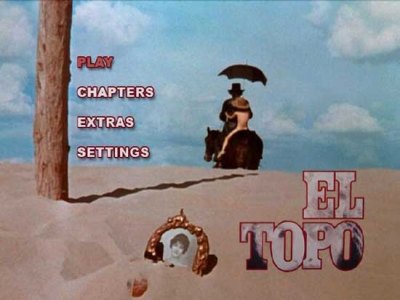
ABKCO Films has also included an all new seven-minute on camera video interview with Jodorowsky who speaks in English about making the film. While he covers some of the same ground here as he does in the commentary track, it's a blast to watch how animated he gets and his sense of humor shines through when he talks about the one benefit of making El Topo was that it allowed him to 'fuck any woman I wanted.' He discusses what it was like mending his relationship with Allen Klein after all these years and he talks about how John Lennon and Yoko Ono introduced the film and helped it to find an audience. Accompanying the video are plenty of clips from the film as well as some archival photographs.
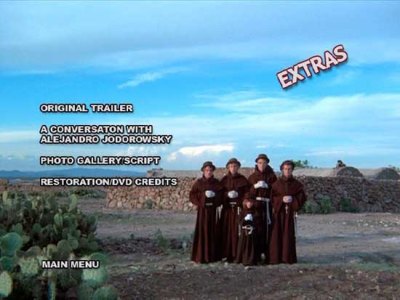
Rounding out the extra features is the film's original theatrical trailer presented with English voice-over and clocking in at almost five-minutes in length, disc credits, and a photo gallery and original script excerpts and production photos.
The Holy Mountain:
Again, ABKCO Films supplies and audio commentary with Jodorowsky, in Spanish with English subtitles. Whereas the commentary on El Topo was more anecdotal and historical, this time around Jodorowsky's talk is more interpretive. He doesn't skirt around the history of the picture but he does put quite a bit of emphasis on explaining the symbols that appear throughout the picture and how many of the sets and set pieces relate to the thief's quest for enlightenment. He points out which symbols were taken from which religions, be they Islamic, Christian, Jewish or Pagan in nature, and he explains the alchemical side of things, the fecal matter into gold scene being a key moment where he delves into quite a bit of detail. He explains how George Harrison wanted to take the lead role but refused to show his anus on screen in the bathing scene and so he passed on that opportunity (he states that it probably cost him millions of dollars in the long run) and talks about why certain people were chosen for certain roles. Again, he covers his use of handicapped people in the picture and points out various scenes that involve some interesting contractions, such as the church full of prostitutes and the scene where the thief finds himself awake in a room full of fake Christs. Jodorowsky explains how he took aspects of many different religions and blended them together in an attempt to make a sacred film that would change people rather than simply entertain them, and he talks about how threats were made on his life by facets of the Mexican government who were upset over what they considered to be blasphemous imagery and with his use of uniforms in the film. This caused him to finish the shoot in New York City, where many of the indoor sets were built and where much of this footage was shot. It's very much to Jodorowsky's credit that he chose this approach for the commentary, as The Holy Mountain can be a very big pill to swallow. It's a heavy film with layers and layers of symbolism and mysticism built into its fiber and having the chance to hear some of the explanations from the writer-director-star's own mouth is very much a great way to garner further appreciation for this truly unique piece of cinema.
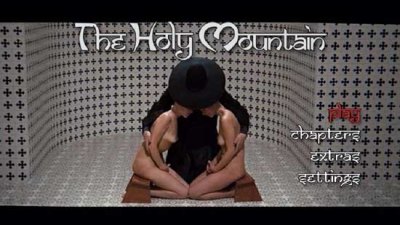
Also included here are some never before seen deleted scenes with commentary in Spanish with English subs. The first scene takes place in a Mexican restaurant, the second scene involves a Zen master's interaction with a student, the third scene again involves the Zen master's interaction with his students and shows them doing a ritualistic dance, the fourth shows the master feeding his students rice, the fifth scene involves the master and his students on the mountain, the sixth scene also takes place on the mountain and involves some rock climbing, the seventh scene deals with skin phobia, and the final scene involves the millionaire's son. Combined these eight deleted scenes run 5:58, and Jodorowsky's commentary explains why each of the scenes was removed and also provides some context for them.
Up next is The Tarot (7:52), a short with commentary that allows Jodorowsky to explain his fascination with Tarot cards and how he identified with much of their symbolism. He explains that The Tarot is not a way of looking into the future but a way of speaking about the present, and how you can use it to set your spirit on something to make it happen. It's an interesting short that fits in with the feature nicely in that it further explains some of the symbolism seen in the film as well as Jodorowsky's beliefs in The Tarot.
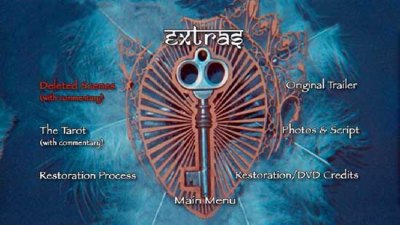
Rounding out the extra features are the original theatrical trailer with English voice-over, a restoration process short (5:30 of side by side comparison footage with narration), DVD and restoration credits, and a photo gallery with production stills and some interesting original script excerpts.
ABKCO Films has also included the complete soundtracks for El Topo and for The Holy Mountain in thin pack cases and with cover art that matches the other four discs in this collection. The track listing for these discs, which have both been given analog to digital restorations, are as follows:
El Topo Soundtrack:
Entierro Del Primer Juguete/Bajo Tierra/La Catedral De Los Puercos/Los Mendingos Sangrados/La Muertes Es Un Nacimiento/Curios Mexicano/El Agua Viva/Vals Fantasma/El Alma Nace En La Sangre/Topo Triste/Los Dioses De Azucar/Las Flores Nacen En El Barro/El Infierno Do Los Angeles Prostitutos/Marcha De Los Ojos En El Triangulos/La Miel Del Dolor/300 Conejos/Conocimiento A Traves De La Musica/La Primera Flor Despues Del Diluvio
The Holy Mountain Soundtrack:
Trance Mutation/Pissed And Passed Out/Violence Of The Lambs/Drink It/Christs 4 Sale/Cast Out And Pissed/Eye Of The Beholder/Communion/Rainbow Room/Alchemical Room/Tarot Will Teach You-Burn Your Money/Mattresses, Masks & Pearls/Isla (The Sapphic Sleep)/Psychedelic Weapons/Rich Man In A Fishbowl/Miniature Plastic Bomb Shop/Fuck Machine/Baby Snakes/A Walk In The Park/Mice And Massacre/City Of Freedom/Starfish/The Climb-Reality (Zoom Back Camera)/Pantheon Bar (Bees Make Honey...)
Final Thoughts:ABKCO Films have done an amazing job on The Films Of Alejandro Jodorowsky. The transfers are great (even if Fando Y Lis and La Cravate aren't perfect), the audio options are varied and of great quality and the supplements are not only plentiful but also quite fascinating. Highly recommended.
Ian lives in NYC with his wife where he writes for DVD Talk, runs Rock! Shock! Pop!. He likes NYC a lot, even if it is expensive and loud.
|
| Popular Reviews |
| Sponsored Links |
|
|
| Sponsored Links |
|
|
| Release List | Reviews | Shop | Newsletter | Forum | DVD Giveaways | Blu-Ray | Advertise |
|
Copyright 2024 DVDTalk.com All Rights Reserved. Legal Info, Privacy Policy, Terms of Use,
Manage Preferences,
Your Privacy Choices | |||||||









